- Due to the sensitive nature of this story and It's recent
occurrence, all names have been deleted from the text in order to protect
the sources of this material.
-
- On the night (Thule time) of December 23rd, 2001, the
Air Traffic Control at Thule AFB began receiving calls from an unidentified
aircraft. The weather was horrible... as is usual for Thule... -52 Celcius,
with snow and sleet driven by a twenty mile per hour wind, with gusts to
thirty five miles per hour... The call letters of the aircraft were badly
garbled, as was the voice transmission, which was coming in on an unused
(obsolete) harmonic of the standard frequency. The only thing that they
could make out clearly was the aircraft's designation... "King Bird
Five Zero". This is not a call, or an official designation of any
sort, it is the designation of a particular type of aircraft.
-
-
-
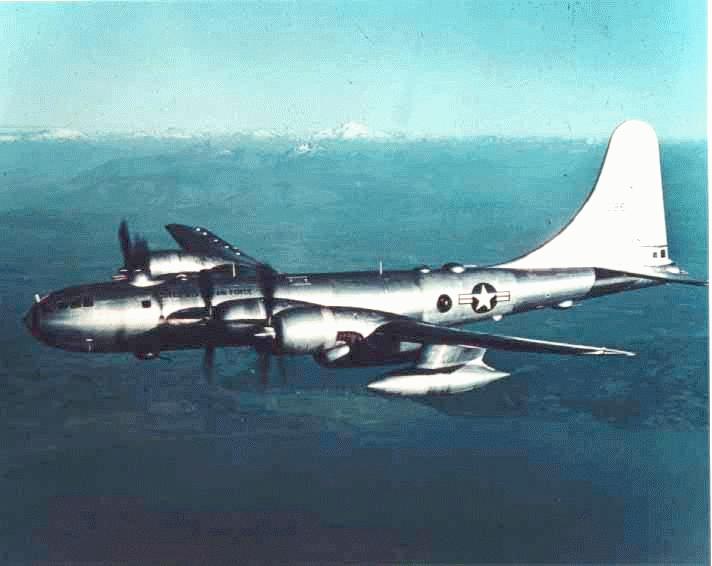
- Typical mid-run B-50 Heavy Bomber.
-
- The aircraft showed on radar as an intermittent blip
of considerable size, although not as large as modern heavy aircraft. Radar
also indicated three other things... First, the incoming aircraft was extremely
slow- moving, by accepted standards, and secondly, it was extremely low.
Any experienced pilot would, if able, get above the current storm front,
and remain there until the last possible minute. The front was a big one...
extending to an altitude of some 42,000 feet, but this altitude was well
inside the maximum ceiling of any known aircraft in service the size of
the incoming "visitir". Unless... the "visitor" had
sustained damage, such as loss of cabin pressure, and could not rise to
this altitude. Finally, there was one other consideration... no military
aircraft was scheduled to be incoming at the time, and there were no scheduled
civilian flights known to be in the area.
-
-
-
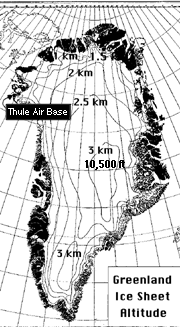
- "Map of Greenland showing the location of Thule
Air Force Base, which was earlier referred to as "Blue West One"
but always called Thule by pilots and groud personnel on site.
-
- Air Traffic Control at Thule Air Force Base first started
making intermittent contact with the aircraft when it was approximately
100 nautical miles out of Thule, over the Atlantic. Somehow, it had simply,
very suddenly, "appeared" as a faint "blip"on Radar,
fading in and out as it progressed slowly Eastward, right in the midst
of the storm. Radio contact had begun at approximately the same time. Messages
incoming were regular, but garbled by interfereence from the foul weather,
coming in on a harmonic (side band) of a long unused military frequency.
The transmissions were voice only, but the voice appeared to be steady,
firm and unconcerned by the horrendous flying conditions prevelent at the
aircraft's cruising altitde 30,000 feet. The timing indicated a set pattern
of transmission, such as the kind of routine positioning reports used in
the days before Radar was either common, or dependable. There was no transponder
signal, and no radar signal imcoming from the aircraft. Thule tower remained
in regular contact with the incoming aircraft for slightly over one hour.
-
-
-
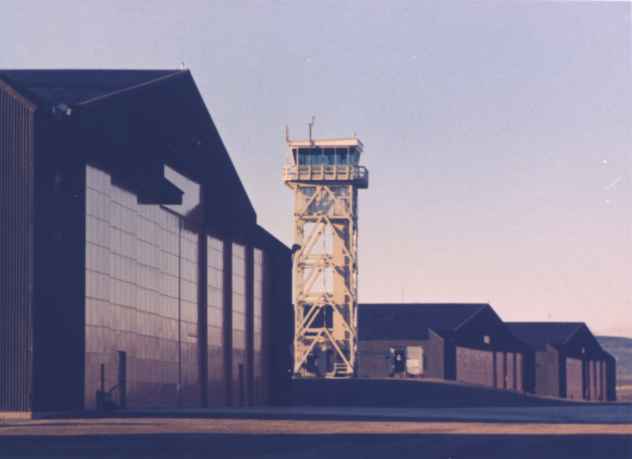
- Air Traffic Control Tower at Thule AFB as it appears
today.
-
- The last message came at 01:07 GMT, at which time the
aircraft was a solid radar image, and approximately 10 nautical miles from
Thule AFB's main runway, over the lip of the glacier. The message, in clear
transmission, stated... "We show to be ten knots out, and should be
able to see you... but we can't see you... light up the night..."
-
-
-
-
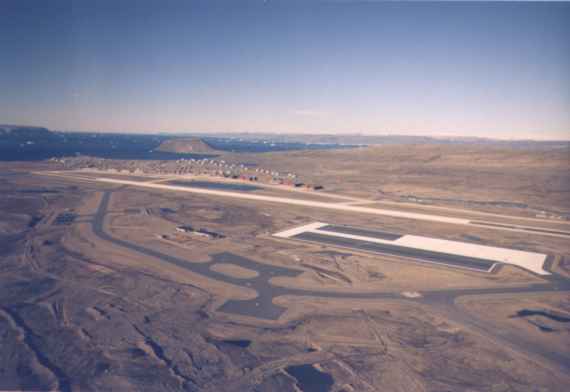
- Aerial photo of Thule Air Force Base taken in the summer
when it is completely free of ice.
-
- Thule AFB is accustomed to having unscheduled visitors
many of whom are in distress. They are capable of and quite willing to
"light up the night". In fact, with all of the emergency lighting
in use, the main runway at Thule is clearly visible, a good deal more than
ten miles out in the worst possible weather. They can also set off a radar
beacon, which is capable of literally making the hull vibrate on incoming
aircraft. None of f ths, however, proved to be of any value. Immediately
afterwards, the in-bound craft vanished from Thule's radar screens, and
there were no further radio transmissions.
-
- Owing to the conditions... darkness and storm... it was
several hours before a search could be mounted for what was assumed to
be an aircraft down on the Greenland Glacier. At first light, a search
party was dispatched to the last known location of the incoming contact.
After a search of approximately two hours, they reported back to Thule
AFB, by radio, informing the Search and Rescue Headquarters that they had
found the "wreckage" of a U.S. Air Force Boeing B-50D Superfortress
bomber... which had belly landed on the glacier, in approximately four
approximately sixteen feet of snow, twelve nautical miles out, in a direct
line with Thule AFB's main runway. The crew was in place... dead.
-
-
-
-
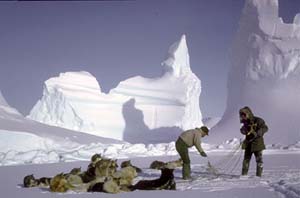
- The Greenland Glacier as it appears in winter, at the
time King Bird Five Zero "landed".
-
- There was no significant damage to the aircraft other
than being completely out of fuel. The amount of snow on the surface of
the glacier apparently cushioned the impact of the bomber. The crew, according
to the logbook, knowing that they were reasonably close to Thule AFB, chose
to remain onboard rather than risk the weather... thinking that a search
would be imminent.
-
-
-
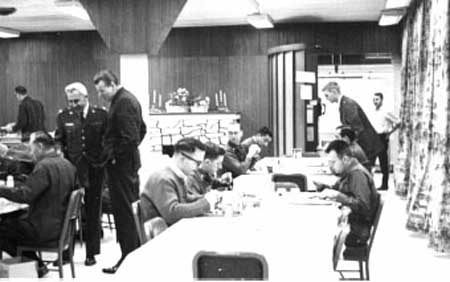
- Personnel at Thule Air Force Base in the late 1940s or
early 1950s.
-
- The aircraft's logbook showed to be up to date until
approximately the time of the last transmission received by Thule Air Force
Base Air Traffic Control... But... it also showed that the flight had originated
at McGuire AFB, New Jersey, on December 22nd, 1948 and that the elapsed
time of the flight the number of hours actually recorded by the crew was
consistent with a flight from McGuire to Thule, at the maximum operational
speed of this type aircraft, given the weather conditions prevelent the
current time. They were, in fact, only two hours behind schedule, due to
the fierce headwind that they appeared to have been fighting. This headwind
also accounts for the aircraft's forcedlanding on the glacier, as the power
requirements placed on the engines under such adverse conditions, more
than doubled normal consumption. The logbook, which is allegedly up to
date until shortly after the time of the plane's crash landing, also indicates
that the crew was aware of their near proximity to Thule AFB, and expected
immediate, or near immediate rescue. They therefore elected to stay with
the craft, rather than venture off toward the Air Base. The condition and
composition of the crew's uniforms indicate that their chances of survival
in the prevalent surface conditions would have been slim to none. Since
the B-50D was developed long before the advent of pressure suits, or extreme
high altitude flying were more than record-setting novelties... the crew
was equipped only with "normal" winter-issue uniforms of the
day, augmented by heavy "B-2" coats. While heavier clothing was
available at the time of the flight's supposed origin, none was found onboard.
While this seemed strange to the would-be rescuers, research later discovered
that the winter of 1948/49 had been considered a "mild" one by
Greenland standards, and the issue would have been quite sufficient for
that time.
-
-
-

- Map showing known electromagnetic anamolies in the vacinity
of Thule Air Force Base.
-
- All this aside, the crew seems to have done the logical
thing by remaining in the aircraft, where there was some protection from
inclimate weather. As it was, they seem to have survived for several hours
after their landing Examination on site, and a later Coroner's report allegedly
indicates that the crew died from shock and exposure. While the bodies
were partially frozen, there was no "frost burn" or other associated
damage from prolonged freezing. Time of death was fixed at ten hours, plus
or minus two, before discovery, wihch is consistent with the time of the
last radio/radar contact with "incoming" unidentified aircraft
by Thule Air Traffic Control.
-
- "Unofficially" the crew and aircraft have been
identified as one which went "missing, and was presumed lost"...
presumed to have crashed into the Atlantic, due to "unknown circumstances"...
on a routine patrol drployment, "some years ago". Since downed
aircraft are common on Thule, and the nature of the far northern location
often means that such aircraft are soon covered over with literally dozens
of feet of snow, this "explanation" is plausible.
-
- The aircraft, a type that went completely out of service
with the Air Force in the late fifties, was the last propeller driven bomber
in the U.S. Air Force invenory. The serial number and log book designation
of the recovered aircraft, match the fragmentary transmissions received
by Thule AFB Air Traffic Control and match the "lost" flight
of 1948.
-
-
-
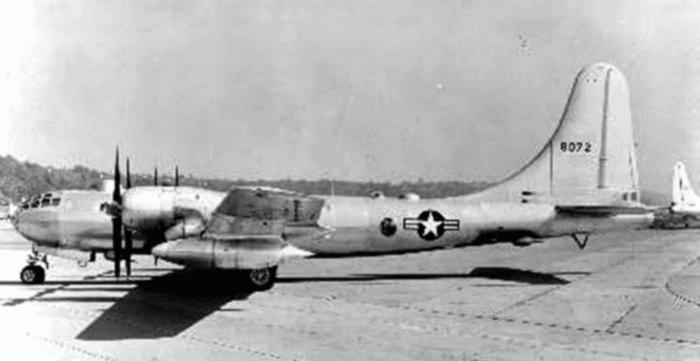
- Early run B-50 heavy bomber, most likely to be identical
in appearance to King Bird Five Zero.
-
- The Heavy long range B-50 Superfortress was developed
from the earlier, Second World War era B-29 Superfortress, the same type
of aircraft which delivered the first Atomic Bombs on Hiroshima and Nagasaki.The
primary difference was a slightly larger rudder assembly, and more powerful,
turbo-prop engines. It was an impressive aircraft, for it's time and the
last propeller driven bomber ever accepted for service in the U.S. Air
Force.
-
- General characteristics
-
- Primary function Long range heavy bomber Power plant
Four turboshaft Pratt & Whitney R-4360-35 engines Length 99 ft 30,2
m Wingspan 141.2 ft 43 m Wingarea 1,720 sq. ft 159.8 sq. m Weight empty
84,714 lb 38,426 kg max. takeoff 173,000 lb 78,472 kg Combat ceiling 35,650
ft 10,900 m Speed cruising 244 mph 393 km/h max. 395 mph 635 km/h Rate
of climb sea level 620 ft/min 189 m/min combat (max. power) 2,200 ft/min
671 m/min Combat radius 2,396 miles 3,856 km Total mission time 20 hours
Maximum load (bombs) 28,000 lb 12,700 kg Crew Eight (pilot, co-pilot, engineer,
radio-electronic countermeasures operator, left-side gunner, right-side
gunner, top gunner, tail gunner) Armament 13x .50-caliber machine guns
Date deployed 1945 Number built 370
-
- While impressive for it's time, beyond any doubt the
most sophisticated aircraft of it's type then in service, a quick look
at the statistics will show that it was ill equipped to handle a major
Arctic Storm being too slow and inefficient in it's fuel consumption to
"fight it's way through", and lacking the altitude maximums needed
to "get above" such a storm. The aircraft also did not have a
pressurized cabin. Like all aircraft of this era, the crew depended only
on breathing masks, and heavy clothing for comfort, coupled with a cabin
heater that operated only when the engines were in use.
-
- According to reports, the aircraft has, since it's recovery,
been transported to a maintaince hanger at Thule Air Force Base. It is
not badly damaged. The plane landed in heavy snow, and aside from some
relatively minor "scarring" and a four slightly bent propeller
blades, there is no real damage. It is estimated that the old plane could
be flown out of Thule in less than three days... depending on weather conditions...
and... if someone could be located who knows how, and has the proper certifications,
to fly this type of aircraft. According to rumor, a search for such a person
is currently underway. Maintaince reports also allegedly confirm that the
cause of the crash was very simple... out of fuel, and a large aircraft,
of this type, can only glide so far... especially into a twenty to thirty-five
mile per hour plus headwind.
-
- The Air Force has supposedly contacted existing next
of kin. The statement says that they have found the remains and that they
are from a crash that happened "some years ago". The bodies are
being "prepared" for return to the U.S. An "official"
statements to the press... not as yet released... but allegedly scheduled
to be released within a few days... will state that in-tact wreckage has
been found, but will give only the date of departure of the flight and
"official" time of loss... 22 December, 1948... and no further
details.
-
- What is the true story behind King Bird Fifty? The oddesy
of the venerable old Cold Warrior poses more questions than answers...
-
- It would appear that "something" swallowed
this plane and it's crew in 1948, and spit it in 2001. There is no evidence
that the aircrew was aware of the passage of time, other than normal flight
time from McGuire to Thule, plus the two hours or so that they were put
behind by the storm. Nor, had the crew, according to reports, aged any.
Their apparent ages match the age recorded for them at the time of their
departure, over half a century ago.. Is there some kind of natural "vortex"
a "portal" that randomly opens in the fabric of space and time?
Are there places in the world in which one can be "swallowed up",
only to be returned at the same place, in a future or past time If this
is so, then all we know of Physics and the so-called "laws" of
nature, are only the beginnings of a dream
-
- What would have been the case if the crew of King Bird
Fifty had survived? What if they had been "rescued"? What would
have been their fate? Would it have been the imprisonment of "government
secrecy"? Would it have been madness? Both?
-
- Is there some short of "paradox shield" in
effect which prevented the crew from surviving the crash? Were they, in
effect, already dead when the aircraft landed? Had they been "dead"
ever since the aircraft disappeared some fifty-three years ago?
-
- Is the flight of King Bird Fifty some sort of naturally
occurring, airborne, "Philadelphia Experiment"?
-
- Is this incident indicatie of some sort of "Bermuda
Triangle" type anamoly?
-
- Has this kind of thing happened before?
-
- Does someone, in fact, know exactly what happened to
King Bird Fifty and her crew? Is it being covered up, like so many other
"unexplained" and "unsubstantiated" paranormal occurences...
for reasons of "national security" or for fear of causing a "panic"...
or is King Bird Fifty the subject (some might say "victim") of
some darker, and more well-thought-out scenario... part of some "experiment"
that people are "better off" not knowing about... some hidden
aspect of the "Cold War" from which the general public is being
"protected"?
-
- Did the incident happen at all, or is it yet another
"mystery" and growing legend of the far north? Is it yet another
"tale of the unexplained"... the kind that seems to simply grow
around aviation, as they once flourished around the ships which plied the
oceans?
-
- There are always "rumors" like the "rumors"
which surround the Roswell Disc and the Bermuda Triangle... like the "rumor"
about King Bird Fifty. "Rumors" that might never come to light
or maybe some day, they will. Who knows? Almost certainly, someone does.
-
-
-
-
- Update - King Bird Five Zero...
-
- Jeff,
-
- The aircraft is being FLOWN. It is operational. That
is what is so unusual about this story. They actually repaired it and FLEW
it back to the states from Greenland...and it is traveling under it's own
power now. This indicates, to us, that it is still being evaluated, or
that they are planning to repeat the experiment on the same aircraft to
try and determine what went wrong the first time.... and something obviously
did.
-
- We were notified about an hour after the plane took off
for the States, and we turned out people up and down the coast, armed with
the ID photos that you have in this article, to try and spot the plane.
We knew the approximate range of the aircraft, so that gave us some pretty
good ideas about destinations. We got three confirmed sightings. They flew
her across, so that she would cross the coast in darkness, but there aren't
that many large, multi-engined reciprocal aircraft around, and this one
is rather noisy, even at altitude.
- From that point on, we sent a description of the aircraft,
and the same ID photos, through our entire email data base, and simply
asked people to be on the lookout. We have been lucky, and have been notified
every time they move her. Right now, she's on the ground, somewhere northwest
of Luke Air Force Base in Arizona. We assume that it's somewhere in Northern
California, given the speed and range of the aircraft. We were notified
when she left Luke (actually a small farm-out base Northeast of Luke, and
given her bearing just after take off.
-
- Interestingly, since we've been covering this story,
we are usually "tipped" accidentally every time there's a move.
Hacking and intrusion activity steps up just before a move. I think that
"uncle" is trying to intercept the sources of our "leads".
It is far to complex to get into in one email, but if you'll look through
the material on our site, you'll get the idea. There is a definate attempt
to keep information on this aircraft under wraps.
-
- We traced one hacking attack that hit me, and one or
our fellow researchers, in Canada, through 14 proxy servers, all the way
back to LANGLEY, Virginia. and a second hacker attack to the Lawrence LIvermore
National Laboratory. We also had one that traced to the Los Alamos National
Laboratory. That particular attack coincided with the aircraft being moved
from Wright Patterson AFB in Ohio to Luke AFB in Arizona.
-
- We have made inquiries of all major organizations involved,
and have received neither a confirmation or denial... they simply say that
"they don't know" about the incident or the recovery of the aircraft
and it's aftermath.
-
- The connection that we have made to this experiment is
as follows. It is all connected with the activity of the Majestic 12 Group,
whch overlaps and interlocks witht he Council on Foreign Relations and
the Trilateral Commission. We have documetnted the overlap on our site.
-
- Chronology:
-
- 1936 (38?) UFO recovery by Germans in Bavarian Alps
- 1942 UFO crash in San Francisco Bay area.
- 1942 Manhattan Project
- 1943 Project Rainbow (The so-called "Philadelphia
Experiment)
- 1945 Technology "acquired from Germany transported
to United States.
- 1947, July, The Roswell Incident.
- 1947, Late Fall, Operation "Highjump".
- 1948 King Bird Incident.
-
- Each of these events is tied together by the presence
of the same scientists being involved, and the same group of "specialists"
in charge of security.
-
- The goal that we have underttaken with this series is
to determine the following:
-
- a. What, exactly happened here.
- b. What became of the remains of the crew.
- c. Is the experiment continuing.
- d. What is the nature of the experiment.
- e. Why is a sixty-year old aircraft still considered
to be "above top secret".
- f. Who is responsible for this.
- g. Who, exactly is involved.
-
-
-
- Comment
-
- From A. Richard Roberts Roamer
1492@aol.com
12-23-2
-
- Hi Jeff,
-
- In response to the articles on King Bird Five-Zero and
the KB-50 that disappeared in the Bermuda Triangle, there is another event
involving a B-50 bomber that occurred in the same area between the Azores
and Bermuda.
-
- According to pilot and author Martin Caiden, an Air Force
Boeing B-50D Super Fortress was en route to Bermuda from the Azores when
the radar operator suddenly realized the aircraft was not moving. Even
though all four engines were operating normally, the plane was maintaining
a stationary position. He reported this to the pilot who, in turn, contacted
Bermuda radar. They confirmed that they had a B-50 on their radar that
seemed to be standing still. The pilot was able to increase and decrease
altitude, but the >aircraft did not move forward.
-
- It was almost an hour before the plane was able to resume
forward motion. Upon landing in Bermuda, a check of the fuel tanks revealed
the consumption far exceeded the amount normally used for the flight. Caiden
said the incident still remains on the books with no explanation.
-
- The source of this information is from an interview with
Caiden in a documentary presented on The Learning Channel, "Bermuda
Triangle: Secrets Revealed".
-
-
-
- Comment
-
- From Joe Pbydreams@aol.com
12-23-2
-
- Jeff,
-
- Found a link into your site and must say its very well
done. As for the B-50 information, I am not an authority on the B-50, but
am pretty well versed in the vintage aircraft game.
-
- King Bird 50 would be the type. A KB-50 is a tanker aircraft.
K stands for tanker and it is a prefix added to the type. C-135 is the
air force version of the 707, but is a cargo plane. KC-135 is the Tanker
or refueling aircraft. NKC-135 would be a type diverted for special nostandard
use, you get the idea...
-
- The B-50 is the perfect aircraft for this type of story
as it is an unverifyable aircraft. There wern't many built and most became
involved in Spook missions flying around the USSR. Kee Bird, a B-29 that
ended up on the icecap and was destroyed in a recovery attempt, was one
such aircraft. These planes were flown in secret missions and many were
lost, shot down by the Russians, or mechanical failure.
-
-
- As for the flying of one today... The USAF would need
help and expertise from the civilian community. There are many restored
aircraft flying around, but a B-50 would not go unnoticed. ANYwhere! If
you do live in the NY area there is a flying/flyable KC-97 from the Berlin
Airlift foundation. A layman would not be able to tell them apart if one
flew over a couple thousand feet up. The B-50 is a large complex aircraft
that was difficult for crews back then. Its a neat story. I wish it could
be true. I just don't think its possible.
-
-
-
- Comment
-
- From Harv Howard
hhoward@ecpi.com
12-24-2
-
-
- In reading the story of "King Bird," I was
struck by the sloppiness and inaccuracies of the tale. And I believe that
is all it is--and I'm an avid believer and experiencer of UFOs.
-
- What first jumped out was that the author stated that
the plane had turbo-prop engines. It absolutely did not. Some later versions
of the tankers were equipped with a pure jet engine on each wing to speed
them up for jet fighter refueling, however.
-
- The basic plane went into service in June of 1947. The
tanker version did not come about until 1957. --So this crash would have
had to happen after that time. Some of these aircraft were still flying
in 1965, but those remaining at that time were all the modified versions
with the extra jet engines. Evidently, the tankers spent most of their
remaining lifetimes doing duty in the Far East.
-
- As a bomber flying in weather (without a bomb load),
it would be expected to be flying high. Its service ceiling was 24,000
to 36,900 feet.
-
- It is completely unbelievable that the crew would not
be flying in winter gear anywhere near Thule! Actually, at those altitudes
without pressurized cabins, any day is winter in about any part of the
world. The crew would have had sheepskin pants, coats, helmets, mittens.
Parts of which were electrically heated.
-
- Basically, if the author can come up with better "proof"
or even convincing details, I would be more apt to consider the possibility
that Spielberg had it right in the opening scenes of Close Encounters,
but until then, it's a nice tale.
-
- Actually, there is a chain of history of such mysterious
and ghost aircraft tales running back for decades. The gimmick of an old,
long-gone aircraft appearing in modern skies is not new. And those are
nothing more than a modern version of the old "Flying Dutchman"
mystery ship tale.
-
- And I had no trouble finding info on the plane by asking
Google for "BK-50 Superfortress."
-
- HH
- Comment
- From Lonnie & Chris Moczydlowski
- moczy@sc.rr.com
- 12-25-2
-
- Truly a fascinating story. The article states that the
call signal was for the designation of the type of aircraft. The designation
K is assigned to aerial refueling aircraft, which would mean this plane
had a much greater range since it is a flying gas station. He must of been
flying around an awful long time to run out of fuel. Of course, that is
assuming that they had been performing their primary mission and had a
full load of fuel. Here is the really intriguing part. If the theory of
time travel is correct, then King-Bird-Five-Zero would have already traveled
back in time since the KB-50 version of this type aircraft did not enter
the USAF inventory until 1956. Prior to this time they were just called
a B-50 and the call signal would have been Bird-Five-Zero.
-
- Thanks,
- Lonnie
-
- Comment
-
- From Michael Hauser
- 12-24-2
-
- Just read with great interest concerning the KB-50.....the
mystery. It was a bit far-fetched, but it's the comments...Q & A's,
that took the cake. You have some strange people viewing this site evidently.
One character was correct, the K designation is used for tankers. There
were a few models equipped for air-to-air refueling, which used an extra
jet engine per wing for added speed. The ideal didn't pan out though.
-
- As far as the woman possibly seeing this particular aircraft
in Arizona, or Texas...the former Confederate Air Force in Midland, Texas
has a Boeing B-29 (Fifi) in which tours the country during airshows. I've
seen this aircraft many times...and it's a spitting image of the B-50.
I doubt if too many people could tell the difference, especially from a
distance. And as far as info on the B-50 not being found...they must be
stupid. On the first attempt, I found loads of info...including serial
numbers to particular aircraft with the KB-50 designation. Someone said
the KB-50's engines were turbo charged...how about supercharged? The old
29 engines were supercharged as well...the 50 probably had larger engines
for more power to handle the extra weight.
-
- Like I said, it made for interesting reading, but better
suited for a Twilight Zone episode. Actually there was one...near identical
about a commercial DC-3 being lost and never found. Later it appeared in
the future...like a ghost plane. Hmm...quite similar...I wonder...???
-
- Thanks,
- Michael Hauser
-
- Comment
-
- From Marilyn Guinnane & Richard Hamilton
- 12-25-2
-
- Jeff - My husband is a bit of an aviation buff. Flew
for Transamerica Airlines as well as Airborne Express in the seventies,
eighties, and nineties, taught pilot training, blah blah. He pretty much
scoffed at the King Bird Five Zero article as it was full of discrepencies.
First of all, those are not turbo prop engines. In paragraph two, my
husband went on, it says that the aircraft was flying extremely low. Then
in paragraph five it says that the aircraft was flying at 30,000 feet,
which is anything but low.
-
- You don't say "ten knots out" ...rather ten
miles out.
-
- The Pratt & Whitney R-4360 is a 28 cyl. radial aircraft
engine. (Seven cyl. around with a total of four rows.) It was turbo-supercharged
by General Electric turbo-supercharger. But, to reiterate, those are not
turbo-prop engines. They were/are piston engines.
-
- The crew compartment was pressurized. Writer says unpressurized.
-
- The writer says that the cabin heater would not operate
unless engines were operating. But the cabin heater required only electrical
power, which could be supplied by the aircraft's APU---which was gasoline
powered, airborne power unit.
-
- Discrepencies such as all these detract from credibility,
beyond question.
-
-
- Comment
-
- From David Hanson davidhanson@cox.net
- 12-25-2
|